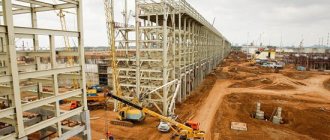Chief engineer - the professional standard in the form of a separate document for this position has not been developed. However, this position is found in a large number of already approved professional standards for production. We will talk about several of them in our article.
Who is a chief engineer
Chief engineer in the field of oil and gas refining
Chief engineer in the field of maintenance of a multi-storey building
You can find more complete information on the topic in ConsultantPlus. Full and free access to the system for 2 days.
About professional standards
Professional standards are a new term that appeared in the Labor Code relatively recently. The definition of the concept of “professional standard” is given in Part 2 of Art. 195.1 Labor Code of the Russian Federation.
Professional standards appeared due to the fact that previously existing qualification reference books do not sufficiently correspond to modern realities in the labor market. Employers must be guided by them when hiring new employees, starting from July 1, 2016, but provided that the mandatory requirements for individual positions and professions, in terms of compliance with the qualifications of applicants, are provided for by other laws and regulations.
HR and legal departments should review job descriptions and employment contracts. This is necessary in order to bring them into compliance with professional standards, since in the latter the requirements for specialists are complex and combine requirements for knowledge, skills, and work experience.
https://youtu.be/mi0FPITtLe8
Professional standards in construction: specific application and code structure
A professional standard is a characteristic of the qualifications that an employee of an enterprise needs to carry out his professional activities. It is mandatory for use if it is prescribed in the provisions of one or another federal legal regulation (Article 195.3 of the Labor Code of the Russian Federation). All professional standards are entered into the state register, available on the website of the Ministry of Labor of the Russian Federation.
Now it is mandatory to use professional standards:
- state and municipal institutions, funds (clause 1 of the Decree of the Government of the Russian Federation dated June 27, 2016 No. 584);
- corporations, companies and enterprises, the share of which is more than 50% owned by government agencies and foundations;
- private business entities whose activities are regulated by relevant legal regulations and in which there are jobs with benefits, preferences or restrictions on working conditions (Article 57, 195.3 of the Labor Code of the Russian Federation).
If there are no regulations on the mandatory use of professional standards in the laws, then, nevertheless, employers should use professional standards as a basis for determining the requirements for the qualifications of employees, taking into account the specifics of production.
Each professional standard recorded in the state register is presented in the form of a 5-digit code, in which:
- the first 2 digits indicate the code of the area of professional activity;
- the next 3 digits indicate the activity code.
In all professional standards in the construction industry, the beginning of the 5-digit code is represented by the number 16. In total, about 93 professional standards have been approved for the construction industry - for each, therefore, a separate 3-digit code of the type of activity is established in values between 001 and 093.
Professions corresponding to the types of activities in the construction sector for which professional standards have been approved can be very roughly classified into the following main groups:
- technical specialists and administrative personnel;
- electromechanics;
- machinists;
- installers;
- operators;
- engineers;
- workers;
- locksmiths;
- workers;
- leadership positions.
Let's look at these groups, as well as the codes that correspond to them, in more detail.
Requirements for the qualifications of a chief engineer
This specialist must have a higher professional education in a technical field (bachelor's degree). As for experience, it is required in the amount of 5 years in a managerial position in the relevant field.
In his professional activities, the chief engineer must be guided by legislative and regulatory acts, decrees of federal and regional authorities/administration, and organizational and administrative documents. He needs to have information regarding the features of the structure and technology of the enterprise, its profile, and the prospects for its development in the technical, social and economic directions.
The engineer must know the requirements and standards of occupational health and safety and fire safety.
IV. Information about the organizations that developed the professional standard
4.1. Responsible development organization
| ONNO "National Association of Self-Regulatory Organizations Based on the Membership of Persons Carrying Out Construction" (National Association of Builders), Moscow | |
| The president | Kutin Nikolay Georgievich |
4.2. Names of development organizations
| 1 | Construction group, Krasnoyarsk city |
| 2 | JSC ", Moscow |
| 3 | Federal State Budgetary Educational Institution of Higher Professional Education "Moscow State Civil Engineering University" (MGSU) National Research University, Moscow |
| 4 | Federal State Budgetary Educational Institution of Higher Professional Education National Research University Higher School of Economics, Moscow |
| 5 | Federal State Budgetary Institution "Research Institute of Labor and Social Insurance" of the Ministry of Labor and Social Protection of the Russian Federation, Moscow |
- All-Russian classifier of occupations.
- All-Russian classifier of types of economic activity.
- Unified qualification directory for positions of managers, specialists and other employees.
- All-Russian classifier of educational specialties.
About the job responsibilities of the chief engineer
The professional standard of the chief engineer also provides for the responsibilities of this specialist. These include:
• determination and implementation of the technical policy of the enterprise;
• searching for ways to reconstruct and technically re-equip production;
• ensuring the proper level of technical condition of production, development and implementation of measures aimed at its growth and cost reduction;
• taking measures to increase production efficiency and labor productivity;
• exercising control over the quality and competitiveness of the company's products (services provided, work performed);
• monitoring the compliance of products (works, services) with current quality standards (technical conditions);
• development of measures aimed at reducing/preventing the harmful effects of production processes on the environment and the careful use of natural resources;
• coordination of patent and invention activities and work related to unification, standardization, certification of products (works, services);
• carrying out research work, experiments, testing new technologies, equipment and equipment;
• organization of training and advanced training for engineers and workers;
• management of technical work. services and control over the results of their work;
• exercising control over production and labor discipline, etc.
Professional standards. 3.3. Labor function of the head of the production and technical department.
Regulatory documents > Professional standards > Construction and housing and communal services. > Specialist in the field of production, technical and technological support for construction production > 3.3. Labor function of the head of the production and technical department.
Labor function
| Labor function | Name | Code | Level (sub-level) of qualification |
| 3.3.1. | Management of the activities of production, technical and technological structural divisions of a construction organization. | C/01.6 | 6 |
| 3.3.2. | Organizational, technical and technological support of construction production. | C/02.6 | 6 |
| 3.3.3. | Management of the development of plans for technical re-equipment and increasing the efficiency of a construction organization. | C/03.6 | 6 |
| 3.3.1. | Management of the activities of production, technical and technological structural divisions of a construction organization. | C/01.6 | 6 |
| Labor actions | Development of long-term plans for the development and technical re-equipment of a construction organization. |
| Implementation of planning, analysis of the results of activities of a construction organization and its divisions. | |
| Management of the development of the work project. | |
| Preparation of proposals for concluding contracts for the development of new equipment, comprehensive mechanization and automation of production processes. | |
| Organization of advanced training of employees in accordance with the development of new types of technology, organization and management of construction production. | |
| Assessing the effectiveness of the professional activities of department employees. | |
| Monitoring the execution of assigned tasks by employees. | |
| Control of the development and implementation of new equipment and technology for construction production. | |
| Joint work with planning, economic and other structures for the purpose of a comprehensive assessment of the effectiveness of the construction organization. | |
| Required skills | Carry out the necessary technical calculations, develop technological schemes. |
| Use a computer using specialized software. | |
| Develop a plan for the introduction of new equipment together with specialists from a construction organization on issues of mechanization and automation of construction production, planning and economics. | |
| Organize and conduct technical meetings. | |
| Draw up contracts for construction and installation work and monitor their implementation. | |
| Evaluate the performance of employees of production, technical and technological departments. | |
| Required knowledge | Basic provisions, regulations governing construction activities, technical conditions, building codes and regulations and other regulatory documents on design, technology, organization of construction production. |
| Fundamentals of design, design features of load-bearing and enclosing structures. | |
| Basic provisions on the organization and management of construction. | |
| Unified system of technological preparation of production; technical specifications and other regulatory materials for the development and execution of technological documentation. | |
| Composition, design requirements and rules for transferring design and estimate documentation. | |
| Composition of the construction organization project. | |
| Composition of the work project. | |
| Structural diagrams of buildings and the sequence of their construction. | |
| Operational management of construction and installation works. | |
| Rules and instructions for the development and execution of technical documentation. | |
| Fundamentals of organization and management using computer programs. | |
| Assessing the performance of department employees. | |
| Other characteristics | — |
| 3.3.2. | Organizational, technical and technological support of construction production. | C/02.6 | 6 |
| Labor actions | Monitoring compliance with the technological sequence and deadlines for performing work by subcontractors. |
| Management of organizational and technological preparation for construction production in accordance with the work project. | |
| Monitoring the preparation of as-built documentation. | |
| Analysis of the results of the construction organization’s activities, preparation of materials for the balance sheet commissions of the construction organization and its divisions. | |
| Development of organizational and technical measures to prepare for construction and installation work in conditions of negative outdoor temperatures. | |
| Ensuring the implementation of rationalization proposals. | |
| Required skills | Calculate the economic efficiency of the designed technological processes for the development of linear and network graphs. |
| Analyze and use regulatory, technical and design documentation in the process of organizational, technical and technological support of construction production. | |
| Apply modern information technologies when designing technological processes. | |
| Required knowledge | Basic provisions, regulations governing construction activities, technical conditions, building codes and regulations and other regulatory documents on design, technology, organization of construction production. |
| Fundamentals of design, design features of load-bearing and enclosing structures. | |
| Basic provisions on the organization and management of construction. | |
| Unified system of technological preparation of production; technical specifications and other regulatory materials for the development and execution of technological documentation. | |
| Composition of the construction organization project. | |
| Composition of the work project. | |
| Structural diagrams of buildings and the sequence of their construction. | |
| Methods for calculating structures of buildings and structures. | |
| Organization and management of processes for the implementation of construction projects from the design stage to commissioning of objects. | |
| Investment mechanism in construction; basics of pricing and estimating; methods and techniques for determining the economic efficiency of capital investments. | |
| Organization of construction logistics and movement of inventory, machinery and mechanisms in the field of construction production. | |
| Other characteristics | — |
| 3.3.3. | Management of the development of plans for technical re-equipment and increasing the efficiency of a construction organization. | C/03.6 | 6 |
| Labor actions | Development of plans for technical re-equipment and increasing the efficiency of a construction organization. |
| Organization of the development of current plans and balances for the material and technical support of the production program, the creation of production reserves based on determining the need for material (materials, equipment, components, fuel, electricity) and labor resources. | |
| Organization of preparation of materials for contracting competitions. | |
| Introduction of computer programs for construction project management. | |
| Management of the development of standards for the consumption of materials, labor costs for performing work not provided for by current standards. | |
| Development of measures to reduce the cost of construction and installation work, increase labor productivity and the quality of construction and installation work. | |
| Monitoring the work of subcontractors performing specialized work in the construction industry. | |
| Study and analysis of the information services market in order to provide production with modern information technologies. | |
| Management of the preparation of applications for the supply of equipment, materials, building structures with the necessary calculations and justifications. | |
| Organization of informing employees of a construction organization about new methods of organization, technology and production management, published in specialized periodicals. | |
| Required skills | Draw up technical specifications for the design and manufacture of non-standard equipment, installation equipment, and embedded parts. |
| Apply the necessary regulatory, technical and methodological documentation, including when preparing contracts for construction and installation work. | |
| Calculate the economic efficiency of the designed technological processes for the development of linear and network graphs. | |
| Apply modern information technologies when designing technological processes. | |
| Introduce energy-saving technologies during construction and installation work. | |
| Monitor the quality of construction and installation work. | |
| Use computer technology in daily work. | |
| Required knowledge | Basic provisions, regulations governing construction activities, technical conditions, building codes and regulations and other regulatory documents on design, technology, organization of construction production. |
| Unified system of technological preparation of production; technical specifications and other regulatory materials for the development and execution of technological documentation. | |
| The range of products and structures produced by auxiliary enterprises of the construction organization. | |
| Basic provisions on the organization and management of construction. | |
| Composition of the construction organization project. | |
| Composition of the work project. | |
| Structural diagrams of buildings and the sequence of their construction. | |
| Methods for calculating structures of buildings and structures. | |
| Innovative technologies for the construction of buildings and structures. | |
| The procedure for developing long-term and annual plans for technical re-equipment and production and economic activities of a construction organization. | |
| Methods of economic analysis of production and economic activities of a construction organization. | |
| Methods for determining the economic efficiency of introducing new equipment, technology and labor organization in construction production. | |
| Other characteristics | — |
Installers
Professional standards for installers have been approved:
- ventilation systems (code 16.029);
- equipment installed in boiler rooms (16.030);
- structures made of concrete and metals (16.047);
- elevators, lifting platforms for disabled people, escalators (16.052);
- formwork platforms (16.053);
- frame-sheathing elements (16.054);
- street pipelines (16,061);
- turbine equipment (16.062);
- process pipelines (16,088);
- sanitary infrastructure (16,089);
- electrical systems in residential buildings (16,090);
- technological infrastructure and structures (16.091);
- automatic control infrastructure (16.092).
Drawing up a professional standard for an electronics engineer
In the summer of 2020, the Ministry of Labor approved the professional standard for an electronics engineer, which includes four sections:
- General information about the profession: goals, group and type of activity according to the OKZ and OKVED classifiers.
- Functional map of the position. It contains information about generalized labor functions and their components. For each, the skill level and code are indicated. In total, the section contains four basic functions and eight of their components. Generalized (basic) functions include the operation of radio-electronic equipment, its components, complexes and systems. Their components include a set of measures for maintenance and acceptance of new (repaired) equipment.
- Detailed description of functions. For each generalized function, requirements for education, work experience, special conditions for admission, as well as additional characteristics are given. Thus, the function “operation of radio-electronic equipment” requires an employee to have a secondary (higher) specialized education and at least a year of work experience, depending on the degree of education, to be allowed to perform it. It is also required to undergo training in labor protection, fire safety, a medical examination and have a second electrical safety group.
- This section also contains a description of the component functions. A list of labor actions, necessary knowledge and skills are given for them. Thus, the function of maintaining electronic equipment includes nine actions, from studying the manual for using the devices to monitoring their condition. Its implementation requires possession of five practical skills and knowledge in seventeen areas. For example, you need to know the conditions for storing and preserving equipment and be able to install it.
- In the conclusion, information about the compilers of the document is given.
Attention! As you can see, the document does not contain a number of information: powers, possible responsibilities, parameters for interaction with other specialists. A job description is used to describe them.







